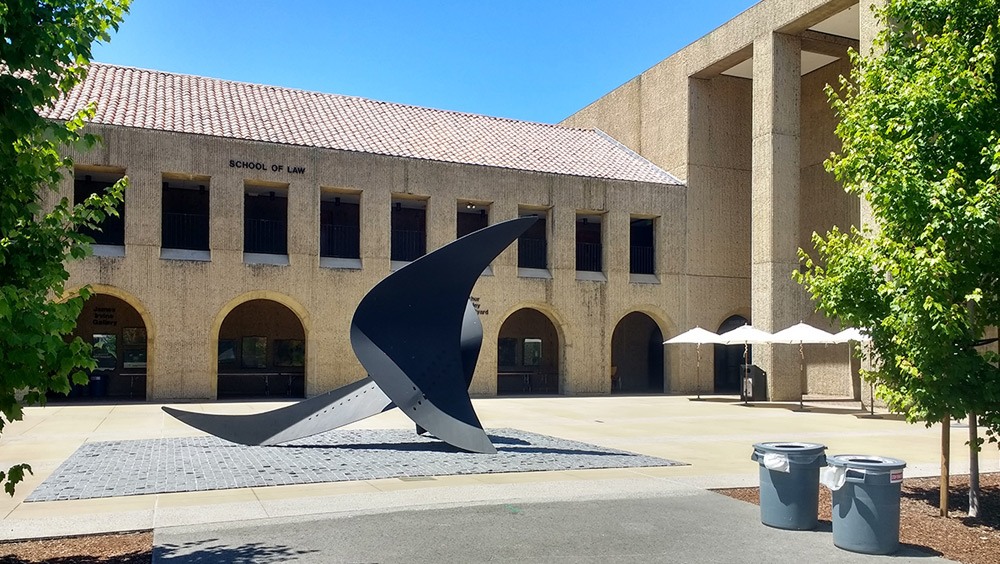A First Amendment Analysis of the Stanford Protests

Whose First Amendment free speech rights are dominant when people shout down an invited speaker on campus? The shouters or the speakers? Both or none?
Stanford University students disrupted an attempted speech in March by a federal judge invited to the campus by a conservative student group. Transcripts, an audio recording of the incident and multiple news reports provide a review of if, when and how First Amendment rights were involved.
Below, we highlight key moments of the Stanford protests and use traffic signals to categorize the First Amendment protection — or lack thereof — of each.
| Green light: Protected by the First Amendment. | |
| Yellow light: Caution, those 45 words might not apply. | |
 |
"Danger" sign: Warning of a hazard ahead. |
| Red light: No First Amendment protection. |
Stanford protests and the First Amendment: An analysis
Green light: The Stanford chapter of the conservative Federalist Society invited U.S. Circuit Judge S. Kyle Duncan to speak in March. Duncan has issued controversial rulings on issues including LGBTQ+ rights, immigration and voting rights. Some students were critical of Duncan's rulings, which have been controversial. Controversial speakers and speech are protected by the First Amendment. Duncan's past speeches and his rulings are not a reason to disinvite him.
RELATED: The ultimate guide to free speech on college campuses
Green light: More than 70 students reportedly sent emails to the student group asking it to cancel the event or move it to Zoom. The First Amendment protects a marketplace of ideas where all may speak, but it doesn't protect a speaker from criticism, opposition or counter-speech. In fact, it encourages such vigorous exchanges of opinion. These students have the right to air their criticism of Judge Duncan.
Green light: In an op-ed article in the Wall Street Journal, Duncan said, "When I arrived, the walls were festooned with posters denouncing me for crimes against women, gays, blacks and 'trans people.'" The First Amendment protects signs, placards and other forms of expressive conduct under the rights of free speech and assembly.
Flashing "danger" sign: In that same piece, the judge said, "Plastered everywhere were photos of the students who had invited me and fliers declaring 'You should be ASHAMED' with the last word in large red capital letters and a horror-movie font." This is a closer First Amendment call: Simply posting critical comments or even photos likely is protected speech. Under certain circumstances, the posts could lose protection, but a prosecutor would have to show that posting the photos was intended to provoke immediate violence or acts of intimidation against the identified individuals.
Green light: As Duncan began speaking, some students in the audience were reported to have shouted personal insults or other derogatory remarks, from "Your racism is showing" to "We hope your daughters get raped." Those insults are vulgar and offensive but also protected speech. Speakers are not immune from occasional hecklers or shouted insults as long as those interruptions are not intended to prevent the speaker from continuing. There's no provision for civility or courtesy in the 45 words of the First Amendment.
Green light: When the judge asked for an administrator to restore order, Tirien Steinbach, the law school's associate dean for diversity, equity, and inclusion, came to the podium. After noting Duncan's right to speak under university policy, she said, "Your opinions from the bench land as absolute disenfranchisement" of students' rights … "It's uncomfortable to say this to you as a person. It's uncomfortable to say that for many people here, your work has caused harm … This event is tearing the fabric of this community that I care about … do you have something so incredibly important to say" that it is worth the "division of these people?"
In an op-ed article in the Wall Street Journal, Steinbach said she didn't "get the balance right" when she spoke. "I stepped up to the podium to deploy the de-escalation techniques in which I have been trained, which include getting the parties to look past conflict and see each other as people," she wrote. "My intention wasn't to confront Judge Duncan or the protesters but to give voice to the students so that they could stop shouting and engage in respectful dialogue."
Steinbach's comments to the judge in and of themselves are protected. There's no zone of forbidden public remarks about a federal judge. But as a university employee, things can get complicated.
Flashing "danger" sign: Reuters reports that Stanford University issued a written apology to Duncan for the students' behavior. The New York Post reports that the apology letter also said, "Staff members who should have enforced university policies failed to do so, and instead intervened in inappropriate ways that are not aligned with the university's commitment to free speech."
Some are calling for Steinbach's dismissal. Stanford as a private university is not bound to observe First Amendment protections as public universities are and would be free to discipline Steinbach for her speech. Even for public institutions, court decisions since 2006 have given government entities greater control over employee speech "pursuant to their official duties."
Stanford may need to consider:
- If Steinbach was speaking in her "official" capacity.
- If her speech violated any provisions in an employment agreement with the university.
- If California's 1992 Leonard Law, which protects student speech rights at private universities, comes into play for faculty members.
Red light: Students get the red light for preventing Duncan, by constant heckling, from delivering his prepared remarks. (He did exchange some blunt comments and retorts with students.) A speaker with unpopular views remains protected by the First Amendment. As multiple U.S. Supreme Court opinions have declared, harsh, argumentative, rude or even offensive language is to be expected in robust debates involving significant public issues. But silencing a speaker for their viewpoint is exactly what the First Amendment was adopted to prevent. For any speaker on a campus, the First Amendment-friendly view is that more information is better than less. As Supreme Court Justice Robert Jackson once wrote that hearing from those whose views you reject may be valuable only if it better prepares you to oppose those views. And the "marketplace of ideas" doesn't work if only some people are permitted to participate.
Yellow light: The apology letter apparently sparked additional protests. The New York Post reported that when the law school's Dean Jenny Martinez went to teach in a classroom after the letter to Duncan, a sizeable group of "black-clad, masked students" filled the room, with signs on the walls about freedom of speech, and that after the class, similarly dressed students lined the hallway from the room to the building exit. Such acts of protest likely would be protected as free speech but might run afoul of any policies intended to protect university community members from acts of intimidation or being placed in immediate fear for their safety. And California's Leonard Law sets a high bar to any disciplinary action for student speech.
Along the rocky road that was Duncan's appearance at Stanford are other issues involving - perhaps indirectly - First Amendment freedoms:
- Duncan and other critics of the student disruption have called on the law school to punish the most vocal student protesters. Which principles will dominate here: student free speech rights, a speaker's right to speak freely or a private university law school's free speech policy?
- Were other faculty members attending the event bound by their teaching or administrative roles to support Duncan's ability to speak, or did their own free speech rights protect them as they reportedly remained silent?
- Do law school students, as future officers of the court, owe judges certain deference when those judges are speaking on legal matters to a law school audience? A classroom is not a courtroom, to be sure, but is that fact weighed with the obligation of law schools to educate their students on both the law and how to practice law after graduation?
The Federalist Society students and Duncan could have expected his presence would spark significant protest.
But the legal system - and our democracy - thrive best with a civil exchange of views, often strongly held, so that debate, discussion and decision can be made with a maximum of available information. A verbal food fight - at a law school or elsewhere - surely is found wanting on that standard in the court of common sense.
Gene Policinski is a senior fellow for the First Amendment at the Freedom Forum. He can be reached at gpolicinski@freedomforum.org.
When Publishers Are Responsible for Harm: Negligent Publication Explained
Jingle Bell Blocked: 10 Holiday Songs That Have Been ‘Banned’
Related Content

